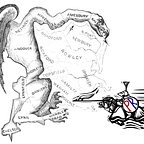Don’t settle for half a democracy.
33% of American voters are represented by a congressperson they voted against. This number can and should be as close to zero as possible, and under 10% is possible. I hope to help fix this before 2022.
Another 13% live in districts where they couldn’t effectively vote against their congressperson, because they had no major-party opponent. (Actually these made up only 11% of congressional voters, because why bother even voting if there’s only one real option?) These numbers can and should be zero. All voters should have meaningful choices.
61% of Americans want a viable third party. They know that the fewer options you have, the less accountable those options become. Even if you end up voting for a major party, you should do so by choice and not just because they have a monopoly; Congress should be more accountable than Comcast.
54% of Americans voted against our current president. Even if you thought that the Electoral College is a good idea, so that the presidential election should be about winning state by state, the fact is that in 9 states, the electoral “winner” had less than 50%. We can fix this, too.
39% of adult citizens didn’t bother voting in 2016. Given all the problems above, that’s not too surprising. If we fix all those problems, is there any doubt that turnout would go up?
US government is designed as a democratic republic. That means that voters choose representatives to make the laws. The ideal can and should be to represent as many voters as possible, at least in the most representative body, the House of Representatives. Our current voting method tries to represent at least 50% in each district, and sometimes fails; in 2016, 9 districts were won with less. A good voting method — any form of proportional representation—would do its best to represent every single voter; even if it fell short of that ideal, it could still easily reach over 90%. In fact, most democracies in the world, aside from the US, UK, and Canada, use some form of prop-rep. This would immediately fix the problem of gerrymandering, reduce polarization and negative campaigning, and increase turnout.
If you’re used to our current voting method, you may find it hard to imagine a system that represents almost 100% of voters. Isn’t “majority rules” the best you can possibly do? In order to see how this is possible, you have to think about electing multiple candidates at once.
Here’s a diagram that’s usually used to explain gerrymandering, but helps understand this issue too:
Look at the left image: “Perfect representation”. With these districts, 98% of the voters get a representative from their favorite party (only the one gray independent voter does not). So approaching 100% is possible; all it takes is a way to group similar votes together. And if you do that, it automatically solves the problem of partisan gerrymandering, since proportional results are guaranteed.
In the other two images, you can see the unrepresented voters, the minority in each district. Proportional voting methods essentially transfer those votes into other districts so as to group them into solid blocks of votes like the image on the left. With 5 districts, you can guarantee that around 90% or more of voters will be represented; with 10 districts, around 95% or more. In the US House of Representatives, averaging big and small states, that would add up to around 94% or more.
The details of how those transfers happen depend on which proportional method you use. For instance, in single transferable voting, voters rank candidates in multimember districts to decide how their votes will be transferred; in PLACE voting (link goes to an example like the above), voters can choose any candidate statewide but there’s still a guarantee of one winner per district.
This one problem, lack of representation, is at the root of many of the deep problems with US politics today, and fixing it would help in so many ways. Fear of wasted votes leaves voters trapped with two unaccountable choices, and that leads to polarization, negative advertising, and destructive infighting between party factions. Gerrymandering reduces voter power, and entrenches even the most-corrupt incumbents. These problems would all be fixed by proportional representation. It doesn’t lead to political utopia, but it does help solve the worst problems.
We don’t have to settle for not being represented. Learn more at the Center for Election Science website, electology.org.
